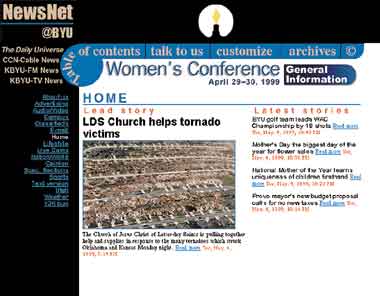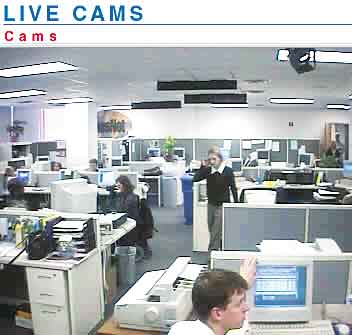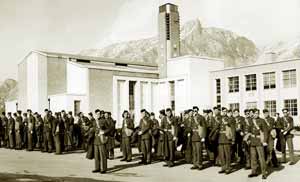By Elyssa Renee Madsen
When BYU NewsNet Web editors arrive at work they watch the Simpsons, play word games, mull over basketball stats, and tinker with HTML.
And in the meantime, they produce the best college online news site in the world, according to Editor & Publisher magazine.

In the integrated newsroom, BYU’s NewsNet staff produces the best college online news site in the world.
NewsNet’s Web team, Chris L. Onstott, Jay Howser, Stephen P. Smith, and Ethan W. Scott, won the 1999 EPpy award for Best College Newspaper Online Service at Editor & Publisher’s 10th annual Interactive Newspapers Conference. This is the first year Editor & Publisher has included college online news sites as one of the contest’s 19 categories and the first time BYU’s three-year-old site has received national recognition–joining ranks with other EPpy honorees the New York Times and the Washington Post.
Calling it “a great resource and a comprehensive online college magazine that uses the Net as a powerful medium,” judges praised the site’s interactive features, timely nature, and strong content.
Indeed, NewsNet’s online site draws from a lot of sources.
The site feeds from NewsNet’s integrated newsroom, one of the first college news services in the country to combine print and broadcast reporting. With information from BYU’s newspaper (The Daily Universe), television station (KBYU-TV), and radio program (KBYU-FM News), and with content developed specifically for the Web, the continuously updated site lets visitors read print stories, watch digitized video clips, view still photos, and hear snippets of radio programming. The site also simulcasts LDS general conference in eight different languages, allowing Church members worldwide to hear conference live instead of waiting months for videotape translations.
With such a wealth of information, one might think the Web team spends long, aching hours converting each piece of news to the required hypertext-markup-language (HTML) format for the Web. They don’t. When NewsNet went online in 1996, J. Scott Johnson, NewsNet’s editorial director, realized they would need a program for Web editors that didn’t require a strong knowledge of HTML.
Thanks to a user-friendly database program developed by NewsNet’s student programmer, James K. Mealey, the Web editors’ use of HTML language is now minimal. Instead the editors, who are all print journalism majors, can focus on what they are best at–being very, very good editors. Editor & Publisher notes, “All pages are built on the fly, which allows the student Web editors to focus on content instead of spending all their time on HTML.”
Johnson thinks the site’s strong content was the determining factor in winning the award. “You can have the coolest site in the world, and it can have all the bells and whistles that have ever existed, but if you don’t have any content people aren’t going to come back,” he says.
 Lately people have been coming back to the site in droves. This past year visits to the site increased 610 percent, from 18,762 visits in February 1998 to 114,309 visits in February 1999. Eighty-eight percent of the site’s traffic comes from outside Utah, with 14 percent outside the United States. People from as far away as New Zealand and Japan visited.
Lately people have been coming back to the site in droves. This past year visits to the site increased 610 percent, from 18,762 visits in February 1998 to 114,309 visits in February 1999. Eighty-eight percent of the site’s traffic comes from outside Utah, with 14 percent outside the United States. People from as far away as New Zealand and Japan visited.
Mealey, a senior majoring in computer science from Kaisersalutern, Germany, says people come to NewsNet’s site because they get a taste of everything news has to offer–print, radio, video, and still photography.
Chief Web editor Chris Onstott, a senior from Dallas, Oregon, says another reason for the site’s popularity is that it has found its niche with stories about the LDS Church. “We have a lot of opportunities to tap a market wanting more information on the LDS Church, especially outside of Utah,” he says.
Visits to the site usually peak in the first week of October and April, coinciding with general conference. A story that ran on Feb. 2, 1999, about the LDS Church’s plans for a family history site was read 38,000 times in February, setting a NewsNet record.
To reach readers across the world and across BYU’s campus, NewsNet recently set up an e-mail service that mails summaries of the top stories to subscribers twice a day. The service provides a link back to the NewsNet home page, where readers can see the full version of the day’s stories. They can also click on a live-camera view of NewsNet’s newsroom, which is updated every three seconds.
And while late-night camera viewers may occasionally see the Web editors checking basketball scores or downing entire pizzas, they will also see them participating in what many feel is the future of news media.
“I like the idea of working with something that is on the cutting edge of technology,” Onstott says. “I see the online site becoming the future for NewsNet.”








